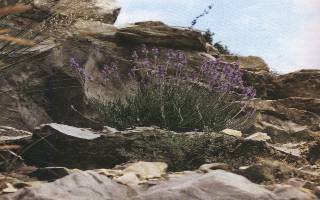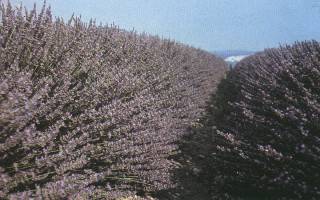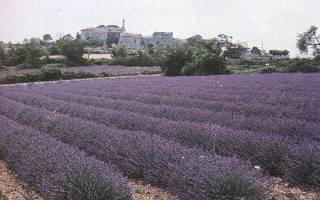


(Image Christiane Meunier)
Pharmaceutical name:
Lavandula officinalis Chaix (syn. Lavandula angustifolia Miller)(Labiatae)
Ancient names:
Nardos, Nardostachus (Gr)
Pseudonardus foemina/masculinum (Lat)
Lavender is part of the Labiatae family, comprising a lot of aromatic
herbs: thyme, savory, oregano, peppermint, sage etc…
We now find lavender or lavandin on all the continents: tradition
tells us that French lavender originated in Persia or the Canary Isles.
We find lavender around the Mediterranean, North America, Australia (Tasmania)…
M Felix Eysseric said that he found lavender in Sweden, adapted to
the bitter winter cold and probably protected by the snow.
"Lavandula Officinalis (in several varieties) grows wild in the south
of France, in Italy, Corsica and Yugoslavia. It is cultivated widely all
over the world, however not always succesfully. Some of these areas are
in Argentina, Brazil, Bulgaria, Cyprus, England, Greece, Hungary, Italy,
Japan, U.S.S.R, Spain, Tanganyika, Tasmania, Turkey and Yugoslavia.
There is some experimental cultivation and distillation in the far
western state of Washington, USA.
English distilled lavender oil from English grown lavender plants deserves
special mention. (maybe in another post since I will be focussing on French
lavender).
Of the other countries mentioned, only Italy is exporting quantities
of any significance.
The production in Tasmania is mainly absorbed by Australia; Japan produces
2-3 metric tons per year which is far from sufficient for its own needs,
and even the Russian production does not cover local consumtion.
The annual production in France varies from about 50 metric tons to
almost 100 tons.
It is difficult, however, to establish accurate figures for the production
of this oil since it is subject to very extensive cutting, adulteration
and other kinds of "handling" during which processes many other locally
distilled oils and synthetic perfume materials are used in quantity."
1961
"Although lavender has been taxonomically classified as Lavandula vera
de Candolle, L.officinalis
Chaix and L.angustifolia Mill., it is the latter name which is the
correct derivation for the commercially grown aromatic member of the Labiatae
family (Tucker and Hensen 1985) …The French oil excels all other
types in quality, possessing a characteristic sweetness of odor; certain
sections of Southern France produce lavender oils with a high ester content
unequaled elsewhere.
Other producing regions:
Italy, Southern Russia, Hungary, England, Australia (Tasmania), United
States…."
Historical
use of Lavender essential oils.
Wild lavender and cultures of lavender and lavandins:
There are in France three "Lavender" growing wild:
-Lavandula vera
-Lavandula stoechas
-Lavandula spica
From this one there are some "subspecies":
-Lavandula vera DC or Lavandula officinalis Chaix. It grows from 700-1800
meter altitude in the Haute Provence, France. The best quality comes from
more than 1000 meter.
There are two natural varieties of the Lavandula vera: -variety "Fragrans",
preferring dry ground with a lot of sun -variety "Delphinensis", preferring
the fresh valleys and more from the sun protected places.
Naturally, in the altitude around 700-800 meters there is a contact
with the Lavandula vera and the Lavandula spica, thus creating through
the bees a natural hybrid form, known as "Lavandin".
These "Lavandins" have intermediar properties of their "parents" and
are habitually sterile.
The first plantations of "Lavandins" came from transplantations of wild
ones to adapted fields,but only in 1925 the technique of cloning was developped
and enabled the apparition of several clones.
There is a very important reason for this "cloning" because the yield
can be 2-5 times higher compared with Lavandula vera.
Clones:
The first succesfull clone was the Lavandin abriale (made by prof.
Abriale), and had a huge succes from 1930 on, replacing most of the transplantations.

(Image Christiane Meunier)
At one time 2/3 of the surfaces were planted with abrialis, before

(Image Christiane Meunier)
a plant disease "fatigue" appeared and the abrialis was partly replaced
by the Lavandin super. Lavandin abrialis was almost completely left behind
later by the Lavandin Grosso. (from 1975 on)
In fact, Lavandin abrialis represents less than 10 percent of the production
in France.
Lavandin grosso. This clone was developped by M. Grosso, from Gault
(Vaucluse).
This clone is robust and productive and became very popular from 1972-1975
onwards. Lavandin Grosso represents 3/4 of the cultivated production
areas, and in certain regions more than 90 percent (Plateau de Valensole).
The yield of Lavandin grosso is three times greather than the Abrialis
clone.
Chemically, Lavandin super and Lavandin abrialis are closest to the
original Lavandula vera.
There are other lavandin clones, less known: the 41/70, Special Grégoire,
33/70, Sumian etc…
Lavender clones:
The clone method was also used with the Lavandula vera, thus creating
the clones "Matheronne" and "Maillette", the Maillette is most widespread,
specially in the Eastern countries and thus replacing the original Lavandula
vera. The Matheronne lavender variety has many advantages in culture and
yield, but produces an essential oil that is not very soluble and therefore
difficult in perfume use. The culture of this variety is almost abandoned.
Some lavender varieties are cultivated solely for the use of the dried
flowers, not for the distillation of essential oil.
Around 1985-90 3000 hectares of lavande fine were cultivated
in France (most Lavande fine and Maillette), 12000 hectares were cultivated
with lavandin (3/4 Grosso, a little lavandin abrialis and lavandin
super.
…Spike or spike lavender, Lavandula latifolia, resembles true lavender,
but grows somewhat taller (80 to 90 cm).
The colour of the flowers is grayish rather than bluish. The volatile
oil contained in the flowers possesses an odor reminiscent of lavender,
but harsher, more camphoraceous.
The quality of lavender essential oils…
"...talking about quality...
even the mention: conformation to the French Pharmacopeia is not a
guarantee:
The French Pharmacopeia contains only some essential oils.
This is for instance what it mentions about lavender:
Essence de lavande
Aetheroleum lavandulae
...from Lavande officinale: Lavandula vera D.C. Lavandula officinalis,
Chaix ex-Villars.
The essence contains a proportion of esters "exprimes" in linalyl acetate
varying between
35 and 55 p 100.
Characteristics:
liquid pale yellow.....
Now, the finest lavender officinalis harvested in the Haute Provence
at more than 1400 m have up to 70 percent linalyl acetate, this would discard
them from the quality mentioned in the French Pharmacopeia.
Any perfume industry in Grasse is able to "make" a lavender oil from
synthetic products, without traces of natural lavender, conform to the
given "standards", and to the Pharmacopeia. This "Lavender" oil will not
be counter indicated for medical use, but the real one, not conform to
the "standards", will!.............."
"Distillers located at high altitude produce oils of higher ester content, not only because of the fact that high-altitude, wild growing plants contain more esters, but also because of the fact that high altitude distillation means lower-temperature boiling. Consequently, the distilled oil is not exposed to 100 degree C. hot steam, but perhaps only to 92 or 93 degree C. Even this small decrease in temperature means that the hydrolysis of the natural linalyl esters take place at a much slower rate. A rapid distillation at slightly reduced pressure (high altitude) may thus produce an oil with nearly all the natural linalyl esters."
Bibliography:
- The Energies of Western Herbs-
Peter Holmes-vol II, 491
-Gildemeister und Hoffmann, french translation, 1900? 1914
-Philippe Mailhebiau, La nouvelle Aromatherapie, Edition Jakin, 2 e
edition
1994
ISBN: 2-940115-00-1 (translated in vivo :) )
-Dr Brian M Lawrence different books from 1979-1994
Allured Publishing Corporation USA
-Stephen Arctander, Perfume and Flavor Materials of Natural Origin,
1961
ISBN 0-9311710-36-7 1994 Allured Publishing Corporation USA
-Huiles Essentielles-hydrolats,
distiller Henri Viaud, Editions Presence,
Sisteron, 1983,
ISBN: 2-901696-33-3
-The Essential oils, Guenther, Robert E Krieger 1949
-Lavandes et Lavandins
Christiane Meunier, Edisud 1985?1992
ISBN 2-85740-597-0
-AFNOR Receuil de normes Françaises 1992, 4 e Edition
ISBN 2-12-177541-2
AFNOR- Tour Europe-Cedex 7
92049 Paris La Defense
France
-Michel Vanhove, Belgium, own experiences and discussions with french
distillers.
 AGORA home page
AGORA home page Go to the FAQ pages............
Go to the FAQ pages............
 This site is hosted by Michel Vanhove
This site is hosted by Michel Vanhove